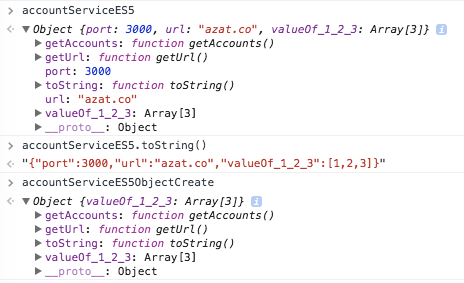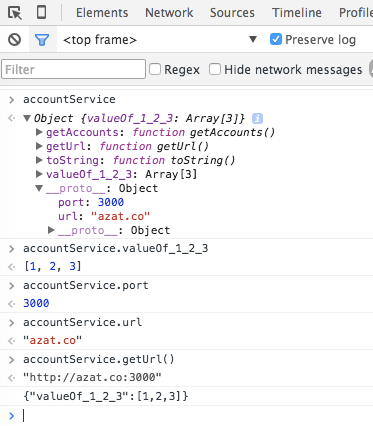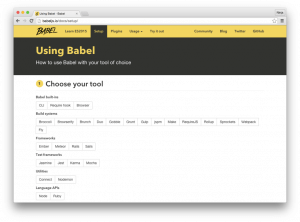以下是ES6排名前十的最佳特性列表(排名不分先后):
- Default Parameters(默认参数) in ES6
- Template Literals (模板文本)in ES6
- Multi-line Strings (多行字符串)in ES6
- Destructuring Assignment (解构赋值)in ES6
- Enhanced Object Literals (增强的对象文本)in ES6
- Arrow Functions (箭头函数)in ES6
- Promises in ES6
- Block-Scoped Constructs Let and Const(块作用域构造Let and Const)
- Classes(类) in ES6
- Modules(模块) in ES6
声明:这些列表仅是个人主观意见。它绝不是为了削弱ES6其它功能,这里只列出了10条比较常用的特性。
1.Default Parameters(默认参数) in ES6
还记得我们以前不得不通过下面方式来定义默认参数:
1 var link = function (height, color, url) {
2 var height = height || 50;
3 var color = color || 'red';
4 var url = url || 'http://azat.co';
5 ...
6 }
一切工作都是正常的,直到参数值是0后,就有问题了,因为在JavaScript中,0表示fasly,它是默认被hard-coded的值,而不能变成参数本身的值。当然,如果你非要用0作为值,我们可以忽略这一缺陷并且使用逻辑OR就行了!但在ES6,我们可以直接把默认值放在函数申明里:
1 var link = function(height = 50, color = 'red', url = 'http://azat.co') {
2 ...
3 }
顺便说一句,这个语法类似于Ruby!
2.Template Literals(模板对象) in ES6
在其它语言中,使用模板和插入值是在字符串里面输出变量的一种方式。因此,在ES5,我们可以这样组合一个字符串:
1 var name = 'Your name is ' + first + ' ' + last + '.'; 2 var url = 'http://localhost:3000/api/messages/' + id;
幸运的是,在ES6中,我们可以使用新的语法$ {NAME},并把它放在反引号里:
1 var name = `Your name is ${first} ${last}. `;
2 var url = `http://localhost:3000/api/messages/${id}`;
3.Multi-line Strings (多行字符串)in ES6
ES6的多行字符串是一个非常实用的功能。在ES5中,我们不得不使用以下方法来表示多行字符串:
1 var roadPoem = 'Then took the other, as just as fair,nt' 2 + 'And having perhaps the better claimnt' 3 + 'Because it was grassy and wanted wear,nt' 4 + 'Though as for that the passing therent' 5 + 'Had worn them really about the same,nt'; 6 var fourAgreements = 'You have the right to be you.n 7 You can only be you when you do your best.';
然而在ES6中,仅仅用反引号就可以解决了:
1 var roadPoem = `Then took the other, as just as fair, 2 And having perhaps the better claim 3 Because it was grassy and wanted wear, 4 Though as for that the passing there 5 Had worn them really about the same,`; 6 var fourAgreements = `You have the right to be you. 7 You can only be you when you do your best.`;
4.Destructuring Assignment (解构赋值)in ES6
解构可能是一个比较难以掌握的概念。先从一个简单的赋值讲起,其中house 和 mouse是key,同时house 和mouse也是一个变量,在ES5中是这样:
1 var data = $('body').data(), // data has properties house and mouse
2 house = data.house,
3 mouse = data.mouse;
以及在node.js中用ES5是这样:
1 var jsonMiddleware = require('body-parser').jsonMiddleware ;
2 var body = req.body, // body has username and password
3 username = body.username,
4 password = body.password;
在ES6,我们可以使用这些语句代替上面的ES5代码:
1 var { house, mouse} = $('body').data(); // we'll get house and mouse variables
2 var {jsonMiddleware} = require('body-parser');
3 var {username, password} = req.body;
这个同样也适用于数组,非常赞的用法:
1 var [col1, col2] = $('.column'),
2 [line1, line2, line3, , line5] = file.split('n');
我们可能需要一些时间来习惯解构赋值语法的使用,但是它确实能给我们带来许多意外的收获。
5.Enhanced Object Literals (增强的对象字面量)in ES6
使用对象文本可以做许多让人意想不到的事情!通过ES6,我们可以把ES5中的JSON变得更加接近于一个类。
下面是一个典型ES5对象文本,里面有一些方法和属性:
1 var serviceBase = {port: 3000, url: 'azat.co'},
2 getAccounts = function(){return [1,2,3]};
3 var accountServiceES5 = {
4 port: serviceBase.port,
5 url: serviceBase.url,
6 getAccounts: getAccounts,
7 toString: function() {
8 return JSON.stringify(this.valueOf());
9 },
10 getUrl: function() {return "http://" + this.url + ':' + this.port},
11 valueOf_1_2_3: getAccounts()
12 }
如果我们想让它更有意思,我们可以用Object.create从serviceBase继承原型的方法:
1 var accountServiceES5ObjectCreate = Object.create(serviceBase)
2 var accountServiceES5ObjectCreate = {
3 getAccounts: getAccounts,
4 toString: function() {
5 return JSON.stringify(this.valueOf());
6 },
7 getUrl: function() {return "http://" + this.url + ':' + this.port},
8 valueOf_1_2_3: getAccounts()
9 }
我们知道,accountServiceES5ObjectCreate 和accountServiceES5 并不是完全一致的,因为一个对象(accountServiceES5)在__proto__对象中将有下面这些属性:

为了方便举例,我们将考虑它们的相似处。所以在ES6的对象文本中,既可以直接分配getAccounts: getAccounts,也可以只需用一个getAccounts,此外,我们在这里通过__proto__(并不是通过’proto’)设置属性,如下所示:
1 var serviceBase = {port: 3000, url: 'azat.co'},
2 getAccounts = function(){return [1,2,3]};
3 var accountService = {
4 __proto__: serviceBase,
5 getAccounts,
另外,我们可以调用super防范,以及使用动态key值(valueOf_1_2_3):
1 toString() {
2 return JSON.stringify((super.valueOf()));
3 },
4 getUrl() {return "http://" + this.url + ':' + this.port},
5 [ 'valueOf_' + getAccounts().join('_') ]: getAccounts()
6 };
7 console.log(accountService)

ES6对象文本是一个很大的进步对于旧版的对象文本来说。
6.Arrow Functions in(箭头函数) ES6
这是我迫不及待想讲的一个特征,CoffeeScript 就是因为它丰富的箭头函数让很多开发者喜爱。在ES6中,也有了丰富的箭头函数。这些丰富的箭头是令人惊讶的因为它们将使许多操作变成现实,比如,
以前我们使用闭包,this总是预期之外地产生改变,而箭头函数的迷人之处在于,现在你的this可以按照你的预期使用了,身处箭头函数里面,this还是原来的this。
有了箭头函数在ES6中, 我们就不必用that = this或 self = this 或 _this = this 或.bind(this)。例如,下面的代码用ES5就不是很优雅:
1 var _this = this;
2 $('.btn').click(function(event){
3 _this.sendData();
4 })
在ES6中就不需要用 _this = this:
1 $('.btn').click((event) =>{
2 this.sendData();
3 })
不幸的是,ES6委员会决定,以前的function的传递方式也是一个很好的方案,所以它们仍然保留了以前的功能。
下面这是一个另外的例子,我们通过call传递文本给logUpperCase() 函数在ES5中:
1 var logUpperCase = function() {
2 var _this = this;
3
4 this.string = this.string.toUpperCase();
5 return function () {
6 return console.log(_this.string);
7 }
8 }
9
10 logUpperCase.call({ string: 'ES6 rocks' })();
而在ES6,我们并不需要用_this浪费时间:
1 var logUpperCase = function() {
2 this.string = this.string.toUpperCase();
3 return () => console.log(this.string);
4 }
5 logUpperCase.call({ string: 'ES6 rocks' })();
请注意,只要你愿意,在ES6中=>可以混合和匹配老的函数一起使用。当在一行代码中用了箭头函数,它就变成了一个表达式。它将暗地里返回单个语句的结果。如果你超过了一行,将需要明确使用return。
这是用ES5代码创建一个消息数组:
1 var ids = ['5632953c4e345e145fdf2df8','563295464e345e145fdf2df9'];
2 var messages = ids.map(function (value) {
3 return "ID is " + value; // explicit return
4 });
用ES6是这样:
1 var ids = ['5632953c4e345e145fdf2df8','563295464e345e145fdf2df9'];
2 var messages = ids.map(value => `ID is ${value}`); // implicit return
请注意,这里用了字符串模板。
在箭头函数中,对于单个参数,括号()是可选的,但当你超过一个参数的时候你就需要他们。
在ES5代码有明确的返回功能:
1 var ids = ['5632953c4e345e145fdf2df8', '563295464e345e145fdf2df9'];
2 var messages = ids.map(function (value, index, list) {
3 return 'ID of ' + index + ' element is ' + value + ' '; // explicit return
4 });
在ES6中有更加严谨的版本,参数需要被包含在括号里并且它是隐式的返回:
1 var ids = ['5632953c4e345e145fdf2df8','563295464e345e145fdf2df9'];
2 var messages = ids.map((value, index, list) => `ID of ${index} element is ${value} `); // implicit return
7. Promises in ES6
Promises 是一个有争议的话题。因此有许多略微不同的promise 实现语法。Q,bluebird,deferred.js,vow, avow, jquery 一些可以列出名字的。也有人说我们不需要promises,仅仅使用异步,生成器,回调等就够了。但令人高兴的是,在ES6中有标准的Promise实现。
下面是一个简单的用setTimeout()实现的异步延迟加载函数:
1 setTimeout(function(){
2 console.log('Yay!');
3 }, 1000);
在ES6中,我们可以用promise重写:
1 var wait1000 = new Promise(function(resolve, reject) {
2 setTimeout(resolve, 1000);
3 }).then(function() {
4 console.log('Yay!');
5 });
或者用ES6的箭头函数:
1 var wait1000 = new Promise((resolve, reject)=> {
2 setTimeout(resolve, 1000);
3 }).then(()=> {
4 console.log('Yay!');
5 });
到目前为止,代码的行数从三行增加到五行,并没有任何明显的好处。确实,如果我们有更多的嵌套逻辑在setTimeout()回调函数中,我们将发现更多好处:
1 setTimeout(function(){
2 console.log('Yay!');
3 setTimeout(function(){
4 console.log('Wheeyee!');
5 }, 1000)
6 }, 1000);
在ES6中我们可以用promises重写:
1 var wait1000 = ()=> new Promise((resolve, reject)=> {setTimeout(resolve, 1000)});
2 wait1000()
3 .then(function() {
4 console.log('Yay!')
5 return wait1000()
6 })
7 .then(function() {
8 console.log('Wheeyee!')
9 });
还是不确信Promises 比普通回调更好?其实我也不确信,我认为一旦你有回调的想法,那么就没有必要额外增加promises的复杂性。
虽然,ES6 有让人崇拜的Promises 。Promises 是一个有利有弊的回调但是确实是一个好的特性,更多详细的信息关于promise:Introduction to ES6 Promises.
8.Block-Scoped Constructs Let and Const(块作用域和构造let和const)
在ES6代码中,你可能已经看到那熟悉的身影let。在ES6里let并不是一个花俏的特性,它是更复杂的。Let是一种新的变量申明方式,它允许你把变量作用域控制在块级里面。我们用大括号定义代码块,在ES5中,块级作用域起不了任何作用:
function calculateTotalAmount (vip) {
var amount = 0;
if (vip) {
var amount = 1;
}
{ // more crazy blocks!
var amount = 100;
{
var amount = 1000;
}
}
return amount;
}
console.log(calculateTotalAmount(true));
结果将返回1000,这真是一个bug。在ES6中,我们用let限制块级作用域。而var是限制函数作用域。
1 function calculateTotalAmount (vip) {
2 var amount = 0; // probably should also be let, but you can mix var and let
3 if (vip) {
4 let amount = 1; // first amount is still 0
5 }
6 { // more crazy blocks!
7 let amount = 100; // first amount is still 0
8 {
9 let amount = 1000; // first amount is still 0
10 }
11 }
12 return amount;
13 }
14
15 console.log(calculateTotalAmount(true));
这个结果将会是0,因为块作用域中有了let。如果(amount=1).那么这个表达式将返回1。谈到const,就更加容易了;它就是一个不变量,也是块级作用域就像let一样。下面是一个演示,这里有一堆常量,它们互不影响,因为它们属于不同的块级作用域:
1 function calculateTotalAmount (vip) {
2 const amount = 0;
3 if (vip) {
4 const amount = 1;
5 }
6 { // more crazy blocks!
7 const amount = 100 ;
8 {
9 const amount = 1000;
10 }
11 }
12 return amount;
13 }
14 console.log(calculateTotalAmount(true));
从我个人看来,let 和const使这个语言变复杂了。没有它们的话,我们只需考虑一种方式,现在有许多种场景需要考虑。
9. Classes (类)in ES6
如果你喜欢面向对象编程(OOP),那么你将喜爱这个特性。以后写一个类和继承将变得跟在facebook上写一个评论那么容易。
类的创建和使用真是一件令人头疼的事情在过去的ES5中,因为没有一个关键字class (它被保留,但是什么也不能做)。在此之上,大量的继承模型像pseudo classical, classical, functional 更加增加了混乱,JavaScript 之间的宗教战争只会更加火上浇油。
用ES5写一个类,有很多种方法,这里就先不说了。现在就来看看如何用ES6写一个类吧。ES6没有用函数, 而是使用原型实现类。我们创建一个类baseModel ,并且在这个类里定义了一个constructor 和一个 getName()方法:
1 class baseModel {
2 constructor(options, data) { // class constructor,node.js 5.6暂时不支持options = {}, data = []这样传参
3 this.name = 'Base';
4 this.url = 'http://azat.co/api';
5 this.data = data;
6 this.options = options;
7 }
8
9 getName() { // class method
10 console.log(`Class name: ${this.name}`);
11 }
12 }
注意我们对options 和data使用了默认参数值。此外方法名也不需要加function关键字,而且冒号(:)也不需要了。另外一个大的区别就是你不需要分配属性this。现在设置一个属性的值,只需简单的在构造函数中分配。
AccountModel 从类baseModel 中继承而来:
1 class AccountModel extends baseModel {
2 constructor(options, data) {
为了调用父级构造函数,可以毫不费力的唤起super()用参数传递:
1 super({private: true}, ['32113123123', '524214691']); //call the parent method with super
2 this.name = 'Account Model';
3 this.url +='/accounts/';
4 }
如果你想做些更好玩的,你可以把 accountData 设置成一个属性:
1 get accountsData() { //calculated attribute getter
2 // ... make XHR
3 return this.data;
4 }
5 }
那么,你如何调用他们呢?它是非常容易的:
1 let accounts = new AccountModel(5);
2 accounts.getName();
3 console.log('Data is %s', accounts.accountsData);
结果令人惊讶,输出是:
Class name: Account Model
Data is 32113123123,524214691
10. Modules (模块)in ES6
众所周知,在ES6以前JavaScript并不支持本地的模块。人们想出了AMD,RequireJS,CommonJS以及其它解决方法。现在ES6中可以用模块import 和export 操作了。
在ES5中,你可以在 <script>中直接写可以运行的代码(简称IIFE),或者一些库像AMD。然而在ES6中,你可以用export导入你的类。下面举个例子,在ES5中,module.js有port变量和getAccounts 方法:
1 module.exports = {
2 port: 3000,
3 getAccounts: function() {
4 ...
5 }
6 }
在ES5中,main.js需要依赖require(‘module’) 导入module.js:
1 var service = require('module.js');
2 console.log(service.port); // 3000
但在ES6中,我们将用export and import。例如,这是我们用ES6 写的module.js文件库:
1 export var port = 3000;
2 export function getAccounts(url) {
3 ...
4 }
如果用ES6来导入到文件main.js中,我们需用import {name} from ‘my-module’语法,例如:
1 import {port, getAccounts} from 'module';
2 console.log(port); // 3000
或者我们可以在main.js中把整个模块导入, 并命名为 service:
1 import * as service from 'module'; 2 console.log(service.port); // 3000
从我个人角度来说,我觉得ES6模块是让人困惑的。但可以肯定的事,它们使语言更加灵活了。
并不是所有的浏览器都支持ES6模块,所以你需要使用一些像jspm去支持ES6模块。
更多的信息和例子关于ES6模块,请看 this text。不管怎样,请写模块化的JavaScript。
如何使用ES6 (Babel)
ES6已经敲定,但并不是所有的浏览器都完全支持,详见:http://kangax.github.io/compat-table/es6/。要使用ES6,需要一个编译器例如:babel。你可以把它作为一个独立的工具使用,也可以把它放在构建中。grunt,gulp和webpack中都有可以支持babel的插件。

这是一个gulp案列,安装gulp-babel插件:
1 $ npm install --save-dev gulp-babel
在gulpfile.js中,定义一个任务build,放入src/app.js,并且编译它进入构建文件中。
1 var gulp = require('gulp'),
2 babel = require('gulp-babel');
3 gulp.task('build', function () {
4 return gulp.src('src/app.js')
5 .pipe(babel())
6 .pipe(gulp.dest('build'));
7 })
Node.js and ES6
在nodejs中,你可以用构建工具或者独立的Babel模块 babel-core 来编译你的Node.js文件。安装如下:
1 $ npm install --save-dev babel-core
然后在node.js中,你可以调用这个函数:
1 require("babel-core").transform(ES5Code, options);
ES6总结
这里还有许多ES6的其它特性你可能会使用到,排名不分先后:
1、全新的Math, Number, String, Array 和 Object 方法
2、二进制和八进制数据类型
3、默认参数不定参数扩展运算符
4、Symbols符号
5、tail调用
6、Generators (生成器)
7、New data structures like Map and Set(新的数据构造对像MAP和set)

来源:https://www.cnblogs.com/dongdongseven/p/7698530.html